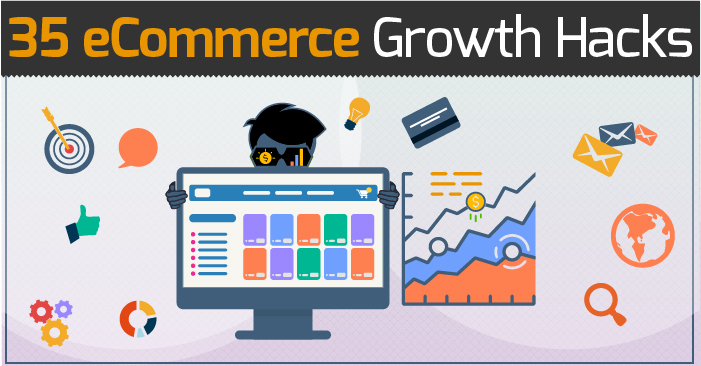
Hi, and welcome to the March 2019 blog post here on AidanBooth.com!
This month I’m sharing 35 eCommerce Growth Hacks, and content comes courtesy of Online Marketing Classroom (OMC), the membership program Steve and I run (which Steve started way back in 2008).
OMC is built around six core pillars:
In addition to updating our members with new content and strategies every month, we also provide exclusive access to custom in-house tools, special discounts, and are involved every day in the OMC community.
We’re incredibly proud of what OMC has become over the past 11 years. To find out more, go here: https://onlinemarketingclassroom.com
Now, on to this month’s content!
The content today is aimed at helping eCommerce stores perform better. We’ve got 35 different tactics for you to consider, and implementing even just a few of them could result in huge gains for your business, or be the difference between success and failure.
The tactics below add to one another, and the synergy helps your business scale in a way not possible with just a single marketing method. This is about taking an asset you already have and turning it into something much more valuable (and profitable).
With that in mind, let’s jump right in…
1. Encourage User Generated Content
86% of millennials report User Generated Content indicates brand quality. Before making a purchase, 68% of users age 18 – 24 take the social media presence of the brand into consideration. ComScore reports the ROI as very high, with brand engagement rising by 28% when user-generated content is combined with brand marketing.
User Generated Content is as it sounds; any sort of content that’s created by users (customers/fans/etc). This may be photos, videos, blog posts, social media posts and so on. The important thing is that it’s created about the brand by someone other than the brand. It’s a 3rd party endorsement.
How to get it?
The best way is by incentivizing customers with some type of reward, such as cash, gift cards, products or simply exposure on your Brand’s website, fan page or in the newsletter.
Run a contest where customers post pictures of themselves using the product to their social media pages with a specific hashtag you specify. Winners can be drawn randomly or chosen by other users.
Sometimes you don’t even have to offer an incentive, you can just ask. Yoga brand Lululemon ran a
campaign with hashtag #thesweatlife, asking customers to post pictures of themselves “getting their sweat on”. 7,000 photos were collected in only a couple of months, and the page they created at #sweatlife got 40,000+ visits.
2. Launch Stores on Multiple Platforms (eBay & Facebook)
Once your primary eCommerce store is up and running, you can expand fairly easily by using your existing images and product copy to set up shop on other marketplace platforms such as eBay and Facebook. As of this writing there are 168 million active buyers on eBay and Facebook marketplace is used by 800 million people monthly.
Selling on these platforms doesn’t require you to send inventory to their warehouse. You only need to put a few additional logistics in place to handle fulfillment, making this a fast method to bring massive revenue growth.
These plugins and resources will help:
- Shopify eBay Plugin
- Woocommerce eBay Plugin
- BigCommerce eBay Plugin
- Shopify Facebook – Accepting applications for integration HERE
- BigCommerce Facebook Marketplace plugin
3. Tap Into The Massive Reddit Community
Reddit users are notorious for hating marketers… which is actually good news.
Every so often a business owner “cracks the code” to gaining trust in the Reddit community and is rewarded with the “blue ocean” that exists there (very little to no competition, but lots of opportunity).
Reddit is the 7th highest trafficked site on the internet. There are 234 million unique users, and it gets 8 billion page views a month. This is a community that rewards you with intense loyalty and lots of sales when you tap into it properly.
The key is to take the time and effort to establish yourself as a trusted community member first. You gain “karma points” on your profile as you contribute value and get upvotes. With enough upvotes, and some emotional intelligence, you can then make useful recommendations that get people over to your website.
That does not mean you suddenly switch from helpful community member into hype-filled marketer. Reddit users hate clickbait and anything that sounds scammy. To get results, be completely genuine and recommend products in the same way you would as if speaking to a personal friend in real life.
4. Incentivize Shoppers with Rewards Programs
Credit card companies have known for quite some time the power of rewards to get cardholders spending as much as possible. Other industries are starting to see the benefits of incorporating this as well, and several apps have been created to execute this on eCommerce shopping platforms.
Shoppers will often buy just to get a reward, and this works to your favor not just on initial purchases but for gaining repeat business as well. People don’t want to “lose” points they’ve already earned, so when conflicted between two similar stores, they’ll usually choose the one they have points at already.
As for incentives, the tried and true “punch card” method where each purchase brings them closer to the reward is just as effective as ever.
Another option is to offer cash rewards (ie $10 cash back for every $100 spent) or points good toward store credit or gift cards.
There are many apps on the marketplace that make it easy to set up Rewards programs for customers.
Below are the highest rated apps for:
5. Automate Social Posting
Why is it that some businesses get huge traction and sales from social media and others don’t, even when they’re in the same industry?
A survey conducted with social media users found that consistency is a major component of what causes a person to follow a brand or not. Frequency is also important. The more often you’re in front of your target demographic, the more memorable and trusted your brand is.
The problem is it takes time to come up with content and post it every day. It’s difficult to maintain when you have so many other daily tasks.
That’s why it’s best to batch your social media content creation and get it all set up in advance so that it’s automatically posting on a regular schedule.
Social media automation tools such as Buffer and Hootsuite are useful to schedule all the content in advance.
6. Customize Website for International Shoppers
If you’re able to ship internationally, your conversions will get a major boost from having a version of your website specifically for users of that country.
This is obviously even more important if they speak a different language. Rather than using a browser extension to translate the site and trying to figure out if the item they want really does ship to their location, users immediately feel confident they can purchase from you.
You can use a translation service like Gengo for the text on your website, or post a translation job on Upwork.
Then implement a tool on your website that detects users’ location and automatically displays the correct version:
- For Shopify: https://apps.shopify.com/geolocation-redirect
- For BigCommerce: https://geotargetly.com/geo-redirect
You’ll want to display prices in the local currency as well, which can be done with an app:
7. Grow Profits Over Time From Continuous Split Testing
An A/B test, also called a split test, is showing 50% of your website visitors one version of a webpage and the other 50% an alternate version where something has been changed, then measuring to see which has a higher conversion rate.
The aim of an A/B test is to bring you more revenue from the same amount of traffic, by increasing the conversion rate of your product pages, checkout process and other assets in the sales funnel. Doing this can open opportunities to acquire customers you previously weren’t able to because the cost was prohibitive. Or, it can simply increase your profit margin.
Although you will build your website with the goal of optimizing it for a high conversion rate off the bat, there are some things you can’t be sure are producing the highest conversion rate possible until you test it. For some businesses, they’re surprised at the winning variable in a split test because all the “experts” told them a different format was better.
Not only that, but the online world is constantly evolving. What worked well a few years (or even a few months) ago may be a conversion-killer now. If you’re continually testing, you’ll gain the edge over competitors who aren’t willing to invest the time.
You’ll get the most benefit from split testing:
- The offer
- Headline text
- The call-to-action
- Buttons – the shape, color, size
- Images
- Videos
- Testimonials
- Bullets and other body copy
- Other social proof elements such as certificates, security badges, partner logos, etc.
- The navigation options – sometimes having no or few navigational elements increases conversion by keeping people focused on the offer, other times sales go up when visitors have easy access to review other pages on the website before purchasing.
- The checkout process – many sales are lost during checkout, so it’s wise to put a lot of focus on optimizing here.
8. Create a Personality For Your Company
Although it’s always been true that consumers connect better with people than faceless corporations, it’s more important today than ever before. Whether or not a company seems genuine and authentic was recently found to be one of the major decision factors when purchasing.
This doesn’t necessarily mean your brand has to have an actual person as a brand representative for customers to connect with. That is one option, but it can be as simple as just making sure your brand itself has a personality.
Brand personality is expressed through the language you use in headlines, body copy, emails and social media content. It’s also expressed through colors, images, logos and so on.
For this reason, having a deep understanding of who your demographic is pays off in a big way. When a customer can relate to the personality traits they feel a brand has, it creates emotional connection and rapport.
9. Welcome Controversial Topics to Generate Discussion
Controversy brings a lot of attention, and attention brings a lot of sales.
There are risks to taking a stand on controversial topics of course, but if you know your audience well and are willing to lose a small percentage of followers, with the added benefit of higher loyalty from those remaining, then it can be well worth it.
Understanding your audience is crucial if you’re going to attempt this. You obviously wouldn’t build a following of animal lovers and then announce support of hunting. However, you can take a stand on important issues within the community, such as being against a particular pet behavior training method, bringing attention as well as loyalty from those with a similar view.
You can also tap into trending controversial topics using a playful method that’s not necessarily polarizing.
As long as you are brave enough, you can attract attention just by being a bit cheeky. Such as, in the middle of a heated political campaign, posting that both candidates would be in a better mood if they had used your company’s travel pillow on their flight. It may be cheesy, and you’ll likely get some snarky responses, but you won’t be complaining about the high open rates, shares, comments and sales that result.
10. Remind Shoppers of Wishlist Items via Email
Shoppers have a tendency to add items to their wishlist and then completely forget about them. Since keeping in touch with customers and subscribers often is important for top of mind awareness anyway, you have the dual benefit of having a reason to follow up that simultaneously is a sales oriented email.
If you use Shopify, there’s an app that automatically sends follow-up emails reminding shoppers of Wishlist items:
11. Proactively Collect Product Reviews
Customers rarely leave product reviews on their own without a reminder. The exception is when they’re unhappy! That means you need to be proactive about gathering positive reviews, as they have a significant effect on sales. BrightLocal found that 85% of shoppers trust internet reviews as they would a personal recommendation.
To gather reviews, the most effective methods are by:
- Including a product insert in the package that asks customers to leave a review, and include the URL where they can post it.
- Sending an email reminder. Yotpo is a good app for automating this. A few weeks after a purchase, Yotpo automatically sends an email to customers asking them to rate/review. It even allows customers to write the review in an email response, which it then posts to the correct product listing.
Yotpo for Shopify: https://apps.shopify.com/yotpo-social-reviews
Yotpo for BigCommerce: https://www.bigcommerce.com/apps/yotpo-social-reviews
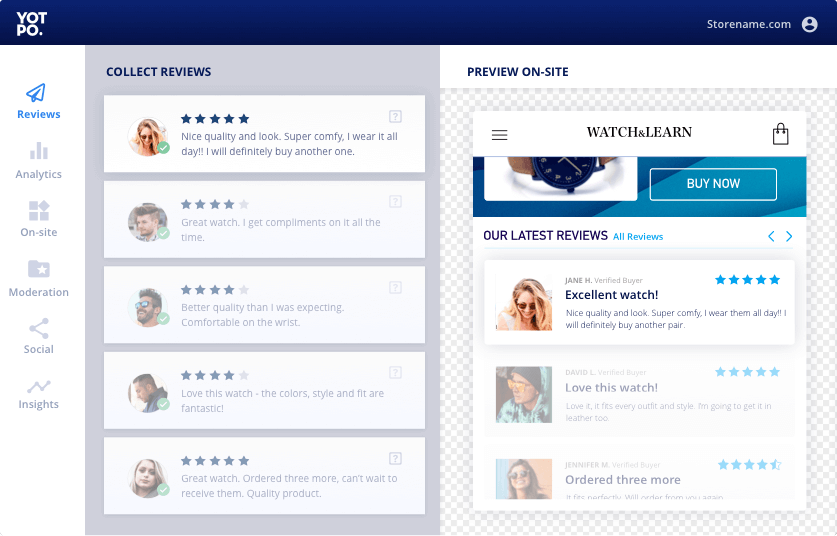
Consider the timing of your review reminders as far as how long it takes to process and deliver the product, and how much time the customer needs in order to use it and see results. You don’t want to ask someone for a review before they’ve even received or used the product.
12. Guest Post for Exposure
Guest posting is known as a popular method for gathering links that help your website rank in the search engines. However, if you connect with popular bloggers in your niche who have high engagement from their followers, you’ll see immediate traffic and sales from your guest posts.
Guestpost.com is a good place to connect with influencers. It helps you find websites in your niche that accept guest posts, keep track of where you’ve submitted posts, and includes email templates for cold outreach to websites you’d like to be published on. It also provides tools for analyzing the stats of a website so you aren’t wasting time creating content for sites with low readership.
13. Use Live Chat to Close Sales
When a shopper can’t find an immediate answer to their questions, they often become
frustrated and with alternative websites being only a few clicks away, it’s easy to lose potential
customers to a competitor who has what they need.
79% of customers prefer live chat support over other channels because it’s the fastest option.
Adding live chat to your website makes shoppers feel like they’re in a ‘real’ store, able to get
their questions answered by shop assistants.
You don’t have to be chained to your website 24/7 to implement this though. You can either set
specific chat support hours, and/or use an app that allows you to answer questions from your
cell phone.

SumoMe shared a live chat trick for gathering more leads while you’re away from the chat. They included an auto-response when not available to answer questions that said:

They found it was a highly effective way to collect email addresses compare to the default of
asking the person to submit their inquiry into the chat box along with email address that you’ll
respond to during normal support hours. Just the slight change in words significantly improved
the number of leads collected.
We’ve analyzed the live chat options available to find those that integrate well with popular
eCommerce platforms and are highly rated specifically by eCommerce store owners.
- LiveChat provides great value for eCommerce entrepreneurs. They have a ticketing
system, goal tracking, and thorough analytics. They integrate with the most popular
shopping platforms, including Shopify and BigCommerce. - Tidio is another option, and has recently added several convenient features for Shopify
stores such as automatically checking the status of an order, product availability and
delivery locations. The satisfaction rate from Shopify users is higher than for
BigCommerce, as these features are currently only available for Shopify stores. - Chatra is a good choice if you’re on a budget, as they have a free plan for solo
entrepreneurs. The paid version allows for multiple support agents. It integrates with
Slack, Google Analytics, and you can reply to support requests with the mobile app
available on Android and iOS.
14. Wow Customers With Handwritten Thank You Cards
Sending personalized, handwritten thank you cards to customers is a huge satisfaction and loyalty booster that gets customers not only returning to buy again, but giving you free advertising by spreading the word to friends and family.
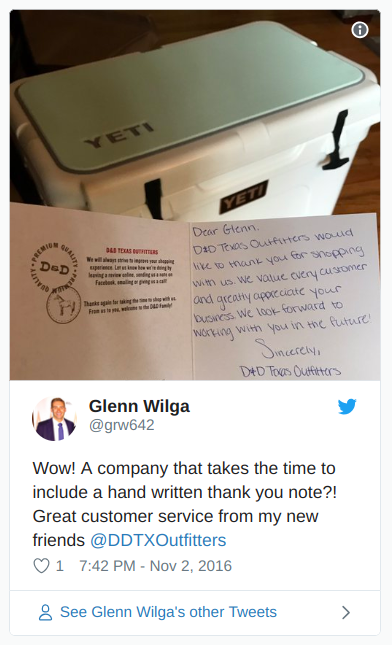
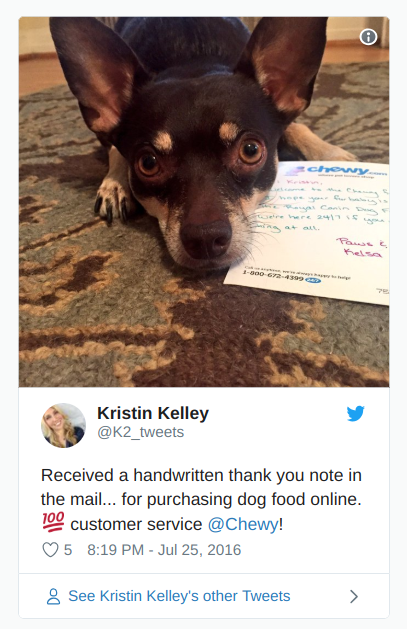
Donors Choose, a non-profit collecting donations for public school classroom projects, tried this method and were able to get 38% of donors returning to give a second donation. The donation amount also increased by an average of $41, resulting in an extra $3 million in donations per year.
Luckily you don’t need to write these cards yourself. You can use a service called Thankbot, which
automates the writing and sending of (handwritten) cards for you.
15. Recapture Shoppers With Exit Intent Popups
It’s a fact in the online business world that most visitors to your website will leave without making a purchase. Since traffic can be expensive to obtain, you want to do everything possible to get the sale or at least contact info before losing the visitor.
The top priority location to focus on is checkout abandonment. These are not just random browsers you’re losing; they’re buyers. Adding an exit intent pop here with a discount coupon and satisfaction guarantee reminder is fast and easy to put in place, and will immediately start recouping sales for you.
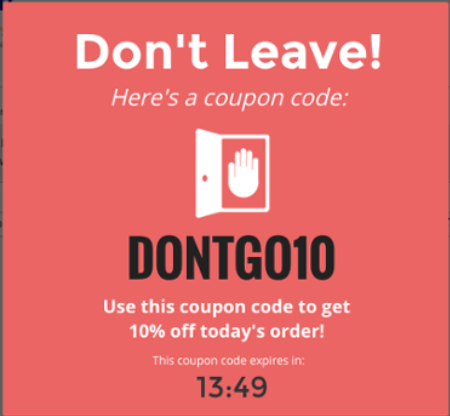
An exit intent popup is triggered when the visitor takes an action that indicates they may close the page, such as rapid mouse movement toward the browser search bar or exit. This isn’t the same as the old school popups that appear ‘after’ a visitor closes the page.
The popular exit-intent popup software options on the market today are:
- Bounce Breaker (created by Steve and I)
- SumoMe
- Bounce Exchange
- Gleam
16. Personalize Homepage For a Conversion Boost
Amazon does a great job of personalizing the homepage; they’re a perfect example to model.
Your sales will definitely go up by using personalization that displays items similar to what someone has purchased or viewed previously. Reminding viewers of products they looked at previously but haven’t bought yet will get a certain percentage of visitors finalizing that purchase.
With the tools available today, you don’t need advanced coding skills to do this. You can use Evergage or Bunting to get it done without being tech savvy.
17. Make Use of FOMO to get Shoppers Buying Immediately
The fear of missing out on something is a strong psychological drive that repeatedly has been proven to get people to take an action rather than procrastinate.
The easiest method to create this in your marketing is by using scarcity in your sales funnel and other marketing creatives.
This can be done by displaying remaining inventory (“only 3 left”), executing a deadline where customers no longer get a discount or bonus after the timer runs out, and using social proof apps to show shoppers that other people are looking at the item and they may lose it if others buy it before they do.

- Inventory Remaining Shopify app: https://apps.shopify.com/pressure-cooker
- Countdown timer Shopify: https://apps.shopify.com/powr-countdown-timer
- Countdown timer & low stock alert Bigcommerce: https://www.bigcommerce.com/apps/countdown-cart/
- Social proof urgency app for Shopify: https://apps.shopify.com/social-proof-urgency
18. Fix Browser Bugs & Incompatibilities
You could be losing many sales simply because your website either doesn’t display the formatting correctly on certain browsers, or has browser bugs.
One way to quickly spot issues is by going to your Google Analytics report at Audience > Technology > Browser & OS report.
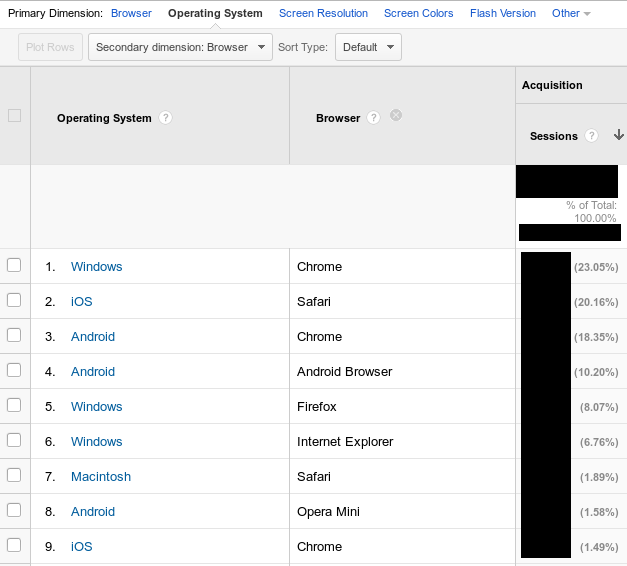
Then, look for browsers that are converting at a lower rate than the others. You may see that IE 10 is converting 3% higher than IE 11, and Firefox 63 is converting higher than Firefox 60.
You can then use a tools such as BrowserStack, CrossBrowserTesting or Browserling to view your website in different browsers and see what the problem is.
Prioritize which to fix first based on the amount of missed revenue (usually highest traffic). Assume that the underperforming version would convert the same as the other and use that to estimate. This can also help you see if it’s worth paying a developer to fix the issue (it may take a few months to recoup the investment).
19. Optimize Input Fields on Checkout For Easy Ordering
Shopping is fun… until it’s time to fill out several lengthy forms. The longer a checkout process is, and the more fields a shopper has to enter, the higher likelihood they’ll abandon.
Make checkout quick and easy by minimizing the amount of information required to complete the order.
Also make use of autofill on forms where it’s allowed such as name, email, address, phone number and other fields that don’t pose any security or privacy threat.
20. Make Returns Easy
As much as people love shopping online, the inconvenience of paying return shipping or restocking fees if the product doesn’t meet expectations or isn’t the right fit is a bit nerve wracking. This fear can prevent purchases.
Do whatever you can to at least pay return shipping; it’s good business. If you can avoid restocking fees, that is best as well.
More than 50% of store shoppers will read the return policy before making a purchase, so be sure it’s easily accessible on all pages, as well as understandable and concise.
21. Satisfy Shoppers “Want it Now” Mentality With Fast Shipping
“Retailers should never underestimate the ‘want it now’ mentality. If customers know that they will receive goods quickly when they order, they’ll keep coming back.” Graham Charlton – Clickz Global
We’ve grown accustomed to getting whatever we want, and getting it fast. Slow shipping will deter
customers nowadays. The faster you can get the customer their item, the easier you’ll win them over. It may eat into your margins a bit, but it will pay off.
This is possible even if you’re doing dropshipping. You can now find US suppliers on AliExpress, using a new search filter available:
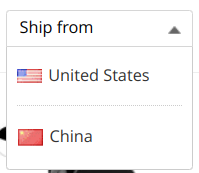
22. Use Shipping Boxes to Promote Your Brand
There are numerous opportunities for your brand to be seen between the time it’s packaged and the time the customer opens it. For instance, sitting on the ground outside the recipient’s house, dorm room, or apartment. Posted on social media because customer’s pets are playing in the empty box. On top of the counter at FedEx waiting for pickup.
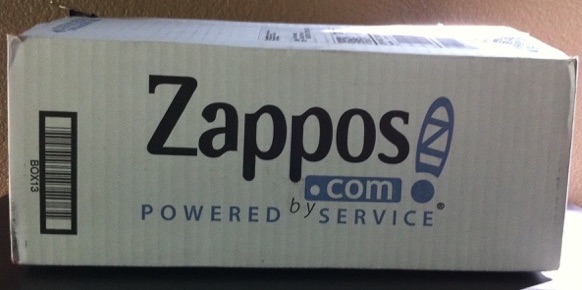
With a clever logo, tagline and website URL, this is an excellent free marketing technique that can bring in new customers.
23. Write a Solution-Focused SEO Title to Maximize Traffic
When someone types an inquiry into a search engine, they’re looking for a solution to something. Perhaps they’re just looking for a suit, but that suit is a solution to something they need. Their “problem” is they need to look dressed up for a particular occasion. By turning your headlines into solutions, you’ll get searchers clicking over to your website instead of competitors:

24. Prove Popularity with Social Proof Apps
Let’s face it… when you see a crowd of people looking at something the natural urge is to look too.
When one restaurant is packed and the other empty, you assume the packed restaurant must be the best and go there.
On the internet you can showcase how popular your website and products are via social proof apps that simulate this experience by popping up a message to website visitors when another visitor subscribes or purchases a product.
Social proof apps such as https://useproof.com/ provide an average conversion lift of 10% and can be set up in 15 minutes or less.
25. Find and Fix Duplicate Content
Duplicate content is extremely common on eCommerce sites, mostly caused by:
- Search Filter Combinations
- Product Descriptions
- Title Tags
You can utilize the free version of Screaming Frog software to identify duplicate content issues on your website.
26. Prevent Chargebacks
Chargebacks are very expensive and can be costing your business a lot of money. Not only do you lose the amount of the original purchase, but you have to pay a fee on top of that.
Most chargebacks happen either because customers don’t recognize the charge on their card, or because their card was stolen and used fraudulently.
Here’s how to combat these issues:
- Make sure the name that appears on your customer’s bank statement matches the name of your brand/store. The more irrelevant the name appearing on their statement is to what your store sells, the more likely you’ll get a chargeback.
- If you do any recurring billing, remind customers ‘before’ their recurring payment is charged. Remind them what name will appear on their bank statement as well.
- Remind customers what name will appear on their bank statement on the order form, ‘and’ in the product receipt.
- Provide exceptional customer service always, and solve unhappy customers problems quickly and thoroughly (make sure they’re happy before closing the ticket).
- Learn how to spot fraud and review it immediately. If you get a fraud alert because an order came in with a different shipping address or name than the billing information, follow up on it and call the customer to verify if you have any suspicions about it.
27. Have a Professional Customer Support Desk in Place
Nothing makes customers more nervous than a “support system” consisting of a free email address with no ticket # or auto-reply confirming receipt of support inquiries. These little things can really make customers apprehensive and hurt your business.
It’s great to be a startup, but you want your customers to feel comfortable and happy with their shopping experience so you can grow. There are free and low-cost options available such as FreshDesk (Steve and I use this) that help you look professional even when on a budget.
28. Use Multiple Suppliers
Imagine one of your products is extremely popular and bringing you sales every day… then your supplier runs out of stock and you can’t sell anymore!
It’s good to have a backup supplier to keep the sales coming in and avoid stock-outs. Your profit margin may be a bit smaller as you won’t benefit from quantity discounts, but a sale at a lower profit is better than no sale at all (and better than causing frustration to customers who want the item and can’t get it).
It also makes sure YOU stay in business even if your supplier doesn’t.
29. Get in Front of Trends to Catch Big Sales Waves
Trendy products spike in sales quickly and die just as fast… if you aren’t in early, you miss out on the big money. However, doing the work to find the next hot product requires a lot of time and boring manual tasks.
Rather than spending hours researching and trying to figure out the next hot product on your own, you can use a tool like Trendosaur or Terrapeak to quickly spot what’s about to become popular, allowing you to get in before everyone else.
30. Easily Expand Product Line via Dropshipping
Having a vast product selection makes your company appear larger and provides you opportunity to gain additional sales via cross-selling and upselling.
eCommerce giant Amazon implemented dropshipping in 2011, and the dropshipped products made up 34% of sold merchandise that year.
Since sourcing your own product takes quite a bit of time, upfront capital and risk, you can add a selection of new products using the dropshipping method. Once one or more of those start selling a lot, you can then work to manufacture it on your own with the security of knowing in advance that it will sell.
31. Create Limited-Edition Bundles
Introduce true scarcity into your store to create an immediate surge of sales, tapping into FOMO and helping keep the reputation of your brand high by proving that limited really means limited.
Consumers are aware that urgency and advertisements of limited quantities are not always true. By adding limited-edition bundles that actually sell out and disappear, it keeps the rest of your scarcity and urgency elements (that may be on a recurring/resetting timer) effective.
32. Automate Tedious Time-Consuming Tasks
You can save dozens (even hundreds) of hours per month on repetitive tedious tasks by using apps such as Dropified, which allow you to:
- Import products from AliExpress and other suppliers (1-Click Import Products to your Shopify,
Commerce HQ or WooCommerce store. Directly import from sites AliExpress, AliBaba, eBay,
Walmart, Costco, Wish, Etsy, SammyDress and many others.) - Easily create dynamic product descriptions
- Edit images within the app
- Quickly find suppliers who have e-packet shipping available
- Automatically orders all bundled products together at the same time
- Gives you access to a list of US product vendors. (For dropshippers selling in the US this helps you get products to your customers faster. The list includes 10,000 products that ship from the US.)
This particular app is unfortunately not available for BigCommerce, however there is a similar service that works on WooCommerce called ShopMaster.
33. Capture Lost Sales With Back in Stock Notifications
Very little annoys customers more than an item being out of stock… and they’ll usually just leave and order it elsewhere.
Luckily you can help combat stock-outs with the multiple suppliers tip offered earlier. However for those cases when you still can’t do anything about it, there is one thing you can do to potentially recapture the sale later. You can send an email to the person as soon as it’s back in stock again.
There’s an app called “Back In Stock”, which collects emails and sends automatic emails with an order button as soon as the item is restocked.
- For Shopify: https://apps.shopify.com/back-in-stock
- For BigCommerce: https://www.bigcommerce.com/apps/instocknotify/
34. Push Notification + Abandoned Cart
The ultimate abandoned cart recovery tool is the push notification. It’s best to get acceptance for push notifications earlier in the shopping process by offering a coupon or other incentive to turn it on. Then, if they abandon their cart later, you can trigger the notification to appear directly on the desktop or mobile device.

35. Track Everything
Track more than you think you’ll need, because what you measure you can improve. Make improvements everywhere you can and watch your business grow exponentially.
It also helps keep your motivation up. If you can’t see what’s improving, you may have a false sense of not progressing – when you actually are improving. Keep in mind this doesn’t mean you need to monitor all stats every day (or even every week). It’ll feel good to look back after several months though, and see all the areas that have grown.
So there you have it, 35 eCommerce Growth Hacks!
I hope you’ve found this useful, if you’ve got a question or tip of your own to share, use the comment box below.
Thanks for reading,
Aidan Booth




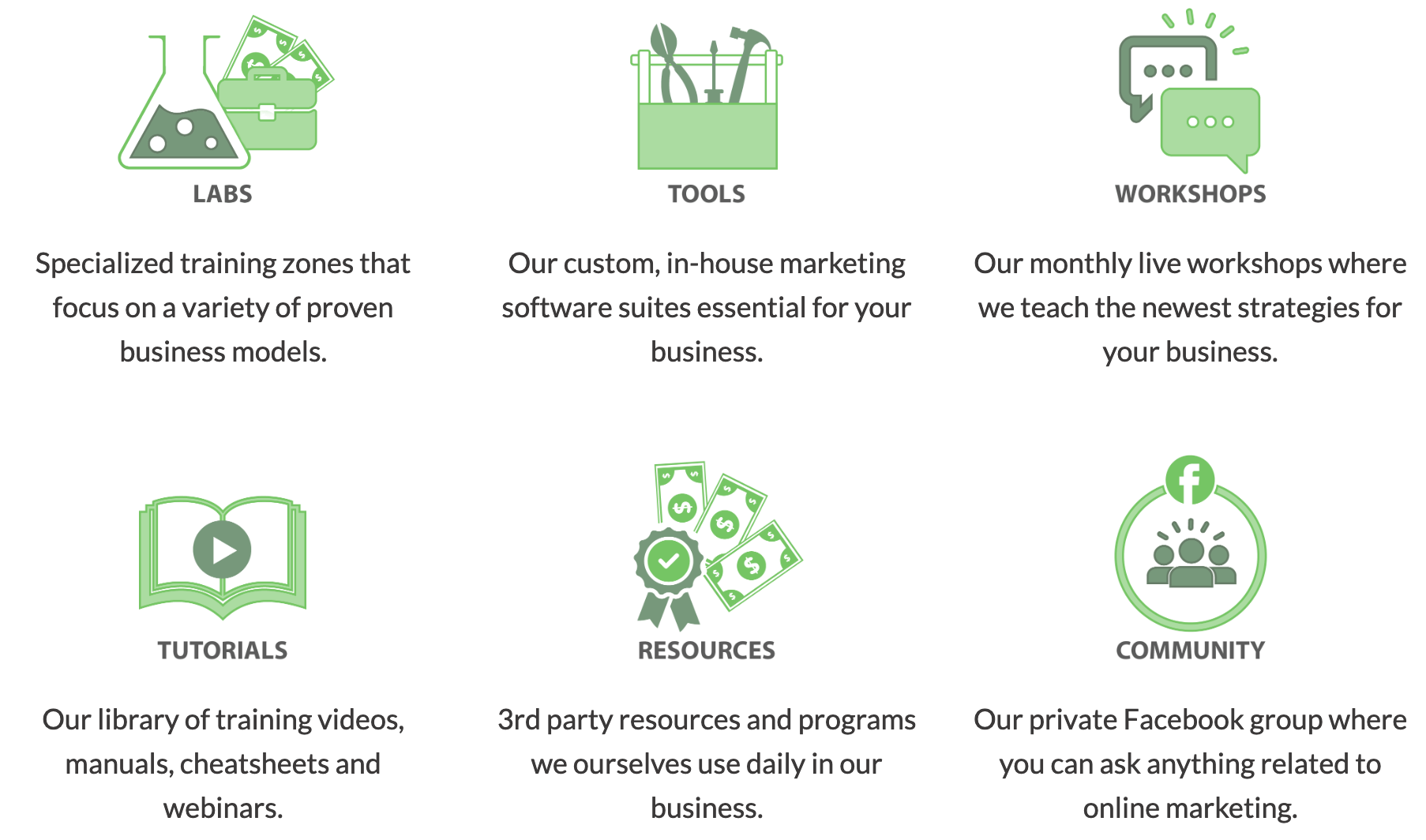




As an OMC member, I’d seen this through the live training, great to read through it again though, so gems in here
Awesome Aaron!
Aidan, what do you think is more of a sure bet, building a dropship Shopify store, or launching a product on Amazon?
If I had to choose one over the other based on what’s working right now, I think I’d probably go the way of Amazon private label… both models are great though.
Great stuff Aidan, lots of good tips that can be implemented immediately to increase conversion rate. All are very relevant and can have a great impact on the results, but if I had to pick just one it would definitely be number 7. Grow Profits Over Time From Continuous Split Testing.
Thanks Ricardo!